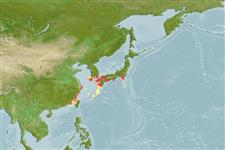Sinonovacula constricta (Lamarck, 1818)
Chinese razor clam| Native range | All suitable habitat | Point map | Year 2050 |

|
| This map was computer-generated and has not yet been reviewed. |
| Sinonovacula constricta AquaMaps Data sources: GBIF OBIS |
تصوير گوگل | No image available for this species;
drawing shows typical species in Pharidae.
رده بندی / Names اسامي عام | مترادف | CoL | ITIS | WoRMS
Bivalvia | Adapedonta | Pharidae
Environment: milieu / climate zone / تغييرات عمق / distribution range بوم شناسي
; تغييرات عمق 0 - 10 m (مرجع 356). Tropical; 35°N - -23°S
Distribution كشورها | مناطق سازمان خوار و بار جهاني (FAO) | Ecosystems | ظهور | معرفي
Indo-West Pacific: China, Hong Kong and South Korea.
Length at first maturity / Size / Weight / سن
بلوغ: Lm ? range ? - ? cm
Life cycle and mating behavior بلوغ | تولید مثل | تخم ریزی | Eggs | Fecundity | Larvae
مآخذ اصلی
مراجع | هماهنگ كننده | همكاران
SAUP Database 2006 SAUP Database. www.seaaroundus.org. (مرجع 356)
وضعيت در فهرست قرمز IUCN
(مرجع 130435: Version 2025-1)
وضعيت از نظر سايتس (مرجع 108899)
CMS (مرجع 116361)
خطر برای انسان ها
استفاده انسانی
ماهي گيري – شيلات: تجاري
FAO - آبزي پروري: production; | FishSource | Sea Around Us
ابزارها
اطلاعات بيشتر
Max. ages / sizes
Length-weight rel.
Length-length rel.
نوسانات طولی
Mass conversion
فراواني
منابع اينترنتي
BHL | BOLD Systems | CISTI | DiscoverLife | FAO(; publication : search) | Fishipedia | GenBank (ژنوم, نوکلئوتيد) | GloBI | Gomexsi | Google Books | Google Scholar | Google | PubMed | Tree of Life | Wikipedia (برو, جستجو) | Zoological Record



